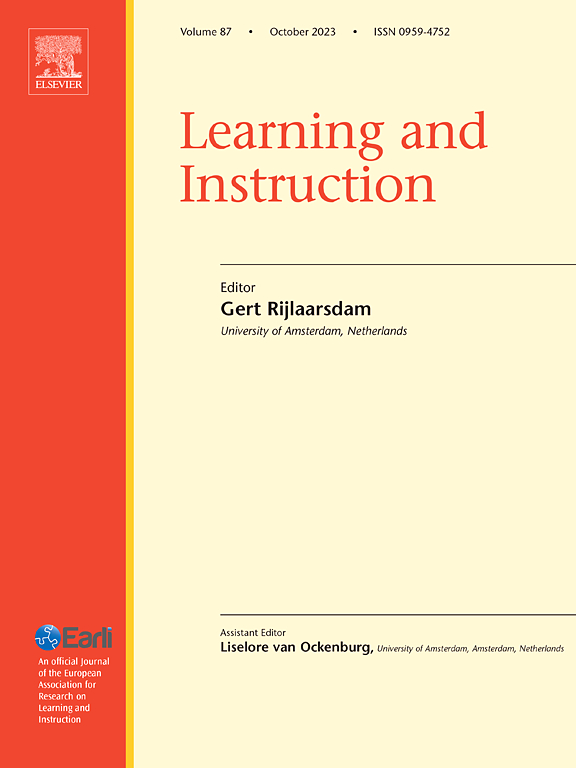Exploring teacher language use and early literacy achievement
IF 4.9
1区 教育学
Q1 EDUCATION & EDUCATIONAL RESEARCH
引用次数: 0
Abstract
Background
Teacher language is crucial to early literacy development, yet limited research has explored how its linguistic complexity and instructional functions evolve over time and relate to student achievement.
Aims
This study explored changes in the linguistic complexity and instructional functions of teacher talk and their associations with student literacy outcomes.
Samples
28 first-grade teachers and their 361 students across 6 schools.
Methods
Utilizing multilevel modeling to address the nested data structure, we analyzed teacher talk collected across the school year, focusing on lexical diversity and syntactic complexity (e.g., type-token ratio, verbs per utterance) and categorized instructional functions. Student outcomes included word reading, reading comprehension, and listening comprehension, with baseline scores and demographic covariates controlled.
Results
The overall volume of teacher talk decreased, while lexical diversity and syntactic complexity increased, reflecting more sophisticated language use from fall to spring. Linguistic features did not significantly predict students’ reading and listening outcomes after controlling for baseline scores and demographic covariates. However, instructional functions showed more complex associations. Management-related talk positively predicted reading comprehension, while praise, explanation, and closed-ended questions were negatively associated with literacy outcomes, particularly for students with lower initial skills. Interaction effects indicated that code-based talk supported word reading primarily for lower-skilled students, while meaning-based talk was negatively associated with literacy outcomes in the same group.
Conclusions
The findings suggest that not all teacher talk equally supports literacy development, highlighting the importance of considering contextual factors and their dynamic roles in shaping students’ literacy outcomes in future research.
探讨教师语言使用与早期读写能力的关系
教师语言对早期读写能力的发展至关重要,然而,关于其语言复杂性和教学功能如何随着时间的推移而演变以及与学生成绩的关系的研究有限。目的探讨教师话语的语言复杂性和教学功能的变化及其与学生读写能力的关系。样本来自6所学校的28名一年级教师和他们的361名学生。方法利用多层次建模来解决嵌套数据结构,我们分析了整个学年收集的教师谈话,重点关注词汇多样性和句法复杂性(例如,类型-标记比,每句话中的动词)以及分类教学功能。学生成绩包括单词阅读、阅读理解和听力理解,基线分数和人口统计学协变量均受控制。结果教师说话总量减少,词汇多样性和句法复杂性增加,反映出从秋季到春季教师语言使用更加复杂。在控制基线分数和人口统计协变量后,语言特征对学生的阅读和听力结果没有显著的预测作用。然而,教学功能表现出更复杂的关联。与管理相关的谈话对阅读理解有积极的预测作用,而赞美、解释和封闭式问题与读写能力的结果呈负相关,尤其是对初始技能较低的学生。交互效应表明,基于代码的谈话主要支持低技能学生的单词阅读,而基于意义的谈话对同一组学生的识字结果呈负相关。研究结果表明,并非所有的教师谈话都同样支持读写能力的发展,强调了在未来的研究中考虑情境因素及其在塑造学生读写能力结果中的动态作用的重要性。
本文章由计算机程序翻译,如有差异,请以英文原文为准。
求助全文
约1分钟内获得全文
求助全文
来源期刊

Learning and Instruction
Multiple-
CiteScore
11.30
自引率
4.80%
发文量
109
期刊介绍:
As an international, multi-disciplinary, peer-refereed journal, Learning and Instruction provides a platform for the publication of the most advanced scientific research in the areas of learning, development, instruction and teaching. The journal welcomes original empirical investigations. The papers may represent a variety of theoretical perspectives and different methodological approaches. They may refer to any age level, from infants to adults and to a diversity of learning and instructional settings, from laboratory experiments to field studies. The major criteria in the review and the selection process concern the significance of the contribution to the area of learning and instruction, and the rigor of the study.
 求助内容:
求助内容: 应助结果提醒方式:
应助结果提醒方式:


